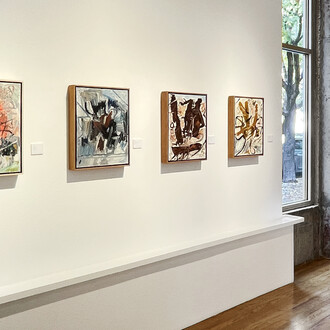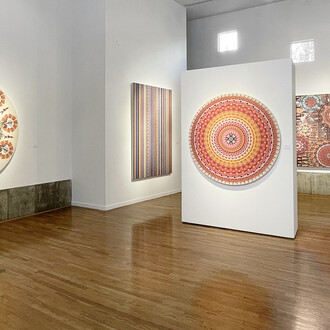In his latest exhibition, longstanding Robischon Gallery artist Jerry Kunkel presents “Descriptors,” as an expansion on his homage to the great historical painters such as Albert Bierstadt, Francoise Boucher, Hendrick Goltzius and Adelaide Labille-Guiard, as well as an expressive side-glance at the nature of culture itself. Kunkel’s layered image and text paintings merge the contemplative with the terse – each presented as the individual works that they are, but also so that each one amplifies the meaning of the other. Kunkel’s expertly -rendered representations, or as the artist says, his “re-representations”, may mine clues from past paintings, but are reimagined in inimitable Kunkel fashion – as a contemporary insider art commentary inserting itself onto the well-vetted stage of those distinguished masters. While Kunkel may juxtapose contemporary and historical images to a revealing or humorous effect, such as a gooey peanut butter and jelly on white bread sandwich side by side a grappling, fleshy Rococo lovers in PB&J and Boucher, it is often the case that in other Kunkel paintings that his blocky typeface and contextual words or phrases are the layer that provides the twist. In combining aspects, Kunkel re-contextualizes every conveyed element of a painting from the time-honored and accepted symbolic interpretation to each considered brushstroke – even as the brushstrokes might be made to look as if from a modern paint-by-number kit. One such painting entitled Like which declares, Facebook-style, from its illusionistic plywood background that This painting doesn't like you. It overly antagonizes an otherwise banal experience of a snowy, rural scene. The seemingly unrelated quips and directives are intended to be alternately bewildering, amusing or allude to a deeper even profound meaning. While it may be true that such relatable statements by the artist such as Pretty Good Isn’t Always Pretty or How Do You Know What You Know begin in an initially clever mode, they can also pose a far more complex question to ponder.
The painting entitled Re-Pose, with the word itself painted on faux plywood via trompe-l’oeil, a constant in the artist’s visual vocabulary - offers Kunkel an opportunity to explore historical norms and cast a satirical light in three, small sections within one painting. The word “RE-POSE,” opposite a re-creation of a self-portrait by the late 18th C French artist Adelaide Labille-Guiard shown behind her easel takes on multiple meanings. Just the word itself may not only refer to the act of posing for the artist, but also to that which was required of or imposed on a female or a female artist of the period – the implications of a posed, dignified manner as something to re-think. Perhaps RE-POSE refers to the all-too-cheerful couple about to take rest or repose – with the woman tucked into her bed as tightly as a squirming child might be and the man, book in hand, implying an intellectual pursuit. Kunkel’s intent for meaning shifts within each composition, by utilizing proximity to a particular image or text. At the same, Kunkel’s additional homage to Labille-Guiard in the exhibition entitled Anonymous Painting re-represents her painting The Sculptor Augustin Pajou, but Kunkel chooses to use digitized, identity-obscuring squares over the subject’s facial features to grant his painted copy anonymity. Quizzically, the painted text states “This painting is apolitical” which is a clever aside to a time when women artists made art that was solely attributed as being painted by “Anonymous” until feminist scholarship added woman artists to the annuls of art history with the scholarship itself standing in as a political act.
Kunkel’s work sparks inquiry; interpretations of each cultural collision presented are only limited by the time allowed for investigation, personal or otherwise. As in the artist’s work entitled Magical Thinking (Hendrick Goltzius), the painting resurrects “Big Boy,” the pudgy symbolic figure from 1950’s American fast food restaurant with his checkered overalls, slicked up swoop of a hairdo and big-eyed grin. By superimposing him over 17th C Dutch artist Hendrick Goltzius’ painted Greek figures Jupiter and Antiope at the precise moment Jupiter takes the form of a lascivious satyr and readies to ravage the beautiful Antiope, Kunkel disrupts the powerfully charged image by the presence of his commercial American icon. Kunkel directly placed the advertising character over the most suggestive portion of the painting altering the meaning of “Big Boy’s” gluttonous gaze once meant only for fast food burgers into a more suggestive, leer of entanglement. Yet, the declaration of Magical thinking makes clear that like the viewer of all Kunkel’s thought-provoking works, “Big Boy” is only a modern-day observer left to muse on the historically portrayed carnal delights. Using images from the recent or distant past, Jerry Kunkel’s wry observational wit and astute word play are directed toward what the artist feels is a shared quest.
Kunkel states, “On good days, I believe we share a common appetite for self-reflection born of a collective and universal desire to comprehend, both physically and emotionally, the world around us. In that light, I am interested in our momentary reaction to everyday stimuli, that moment that summons a private response - a response that we may not feel compelled to share for a variety of reasons; perhaps because it doesn’t seem important, that our response is not fully formed, or we simply don’t care to think about why we really don’t care. Frequently we may perceive our first response to be simply unimportant, all too obvious, unoriginal, embarrassing, impolite, unnecessary, or just plain stupid. To respond may also cause us to question what we thought we knew to be true, verge on shameless sloganeering, or force us to take heed of yet another thing we seem to have taken for granted. However simple, self-protective, or diversionary the response, it can always be complicated upon closer examination, by changing a word, by questioning what we think we know and our attendant level of mindfulness, or by retracing our steps while trying to remember just where the F*** we left our keys.”
Jerry Kunkel is Professor Emeritus at the University of Colorado. He has a BS from Ashland College and an MFA from Southern Illinois University, Carbondale. His work is included in the Denver Art Museum, the Kirkland Museum, the Auraria Campus, Kansas University Hospital and numerous corporate and private collections. Kunkel’s paintings have been exhibited at the Denver Art Museum, Denver Biennial of the Americas, Mizel Center of the Arts and Culture, Akron Art Institute, Rochester Art Museum and Indianapolis Art Museum, among others. He recently published his first novel entitled The Phone along with a collection of short stories and observations, The Unmade Bed.
















